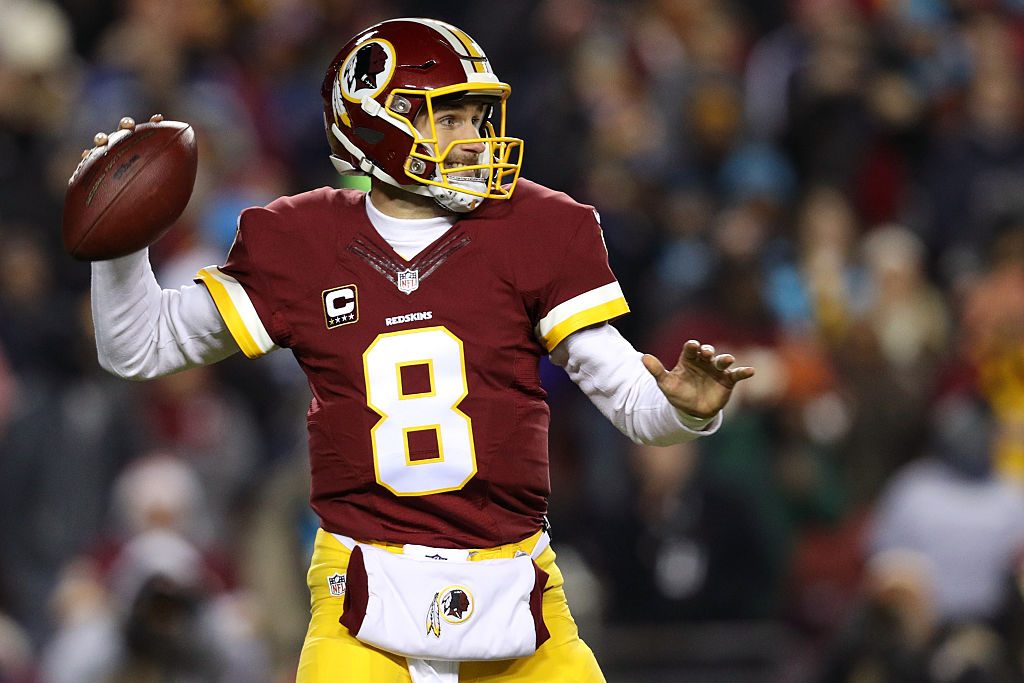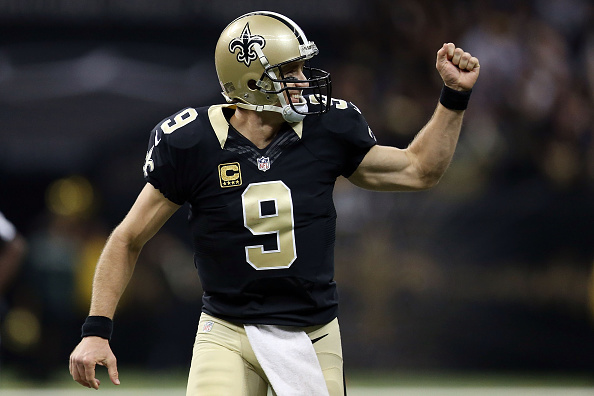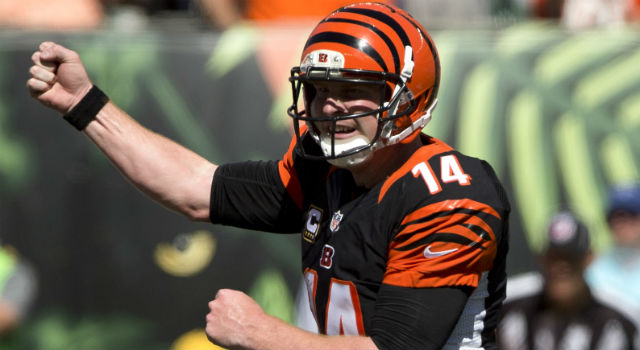We’re still months away from the start of the 2017 NFL season. While all 32 teams are readying themselves for what this year will bring, finalizing draft boards and preparing for positional battles up and down the roster, they also have their eyes pointed even further in the future. After all, teams aren’t after fleeting success, but success of the long-lasting sort. Thus, the decisions made in 2017 need to not only affect the current year but those which follow.
There are few more critical decisions that teams can make than those concerning the quarterback position. It’s a position of scarcity by nature, with only 32 designated starters and not too many more than that who typically see playing time in a given regular season. But as difficult and stressful as it can be to try to find a franchise quarterback, it can be equally so when it comes time to decide when a team’s long-time offensive leader is no longer the asset he once was. Age, performance, salary or a combination thereof can force teams into making difficult decisions. There is nothing more constant in the NFL than change.
With that in mind, here are five quarterbacks who could be on their last seasons with the teams they have played with throughout most, if not all, of their professional careers. While that doesn’t mean their careers will come to an end at the close of the 2017 season, it does mean that these five passers could be spending the season wittingly or unwittingly auditioning for a new job rather than fighting to keep the one they have.
Andy Dalton, Cincinnati Bengals
In Andy Dalton’s first five years as the Cincinnati Bengals’ quarterback, his team reached the playoffs. Each time, the team went one-and-done with Dalton both fairly and unfairly handed the blame. He’s thrown one playoff touchdown pass to six interceptions, but has a 56-35-2 regular-season record on his career. Despite his postseason performances not matching his regular-season body of work, he was given a six-year, $96 million extension in 2014, ostensibly cementing him as the Bengals’ franchise quarterback.
But Dalton’s contract has been heavily front-loaded with guaranteed money, allowing the Bengals to move on in its later years for very little to no dead money charges against their salary cap. Those easy outs begin in earnest following the 2017 season. This year, Dalton will be making $15.7 million (not including playoff- and playing time-related escalators), a number that rises to $16.3 million in 2018. But to release Dalton next year will cost the Bengals only $2.4 million. Given how 2016 (6-9-1) went for the quarterback and how 2017 looks to be shaping up, it’s possible Dalton becomes one of the Bengals’ scapegoats if it indeed ends in disappointment.
Dalton spent his first five seasons playing behind one of the best pass-protecting offensive lines in the league and surrounded by myriad receiving targets, ranging from A.J. Green to Marvin Jones to Mohamed Sanu, plus tight end Tyler Eifert and running back Giovani Bernard. But in 2016, Jones and Sanu were gone, signing elsewhere as free agents. While Green remained, Dalton’s second-best target was Brandon LaFell, while the receivers Cincinnati drafted to replace Sanu and Jones—Tyler Boyd and Cody Core—combined for only 803 yards and one touchdown.
Andy Dalton : 19/28, 308 yards, 2 TD’s & a 128.3 QB Rating
AJ Green : 8 catches, 169 yards & 1 TD (3rd game w/ 150+ yards this season) pic.twitter.com/E93CDJL13i— Lee Harvey (@MusikFan4Life) October 23, 2016
Even more concerning: Dalton was sacked 41 times, the most he’s been taken down in his career, thanks to Cedric Ogbuehi moving into the starting left tackle spot and Jake Fisher working at right tackle, mostly at the end of the season. Though Andre Smith is back in the fold, the Bengals want him to work at right guard this year, a position he has never played, while Ogbuehi and Fisher are again thrown into the fire at tackle. It’s not looking good for Dalton.
Furthermore, the Bengals have a backup quarterback they appear to like in A.J. McCarron. Though McCarron has recently been the subject of trade rumors—quarterback is a hell of a drug—it’s not something the Bengals seem willing to entertain. If Cincinnati has recognized that their once wide-open playoff window has snapped closed and that the state of the offensive line and receiving corps is one of rebuilding, then starting over with the more affordable McCarron may be a more logical approach for the team to take in 2018.
Future Home?
Perhaps the Cleveland Browns would have some interest in Dalton in a year’s time, given that Hue Jackson—the man who worked so hard (and to some degree, succeeded) in molding Dalton into a franchise quarterback in Cincinnati—is their head coach. But the Browns are in prime position to get a long-term quarterback via the 2017 draft, so a pursuit of Dalton would only occur if their to-be-determined rookie ends up being a swing and a miss.
Philip Rivers, Los Angeles Chargers
A clip of the San Diego Chargers final touchdown. A TD pass from Philip Rivers to Hunter Henry pic.twitter.com/seU8Maha3V
— Adam (@SD_Sports19) January 27, 2017
It initially seemed that Philip Rivers would choose retirement over following his Chargers from San Diego to Los Angeles, but that all seemed to change after he received a four-year, $83.2 million contract extension in 2015, before the team’s move was finalized. Now, he’s singing a different tune, embracing the relocation of the team he’s spent his entire 14-year fronting. But those big bucks and his newly-positive attitude may not be enough to assure that his job is secure through the end of his current deal, which expires after the 2019 season.
For one, Rivers is 35 years old and turns 36 near the end of the 2017 season. For another, he’s also taken quite a beating over his career, being sacked 361 times and 112 times over the last three years alone. New Chargers head coach Anthony Lynn has also been transparent about his desire to add a young quarterback this year, one who would be the true heir apparent to Rivers.
Though Rivers’ recent extension will cost the Chargers $21 million in cap space in 2018, he would cost $12 million to release, a number that drops to $6 million should the team cut him with a post-June 1 designation. Rivers’ release, however, would have to be tied to another struggling season. The Chargers have won a combined nine games over the last two years; another four- or five-win year could trigger another round of rebuilding, and provide an easy out for the Chargers, for Rivers or for both.
Future Home?
Whenever Rivers’ Chargers career comes to an end, whether following the 2017 season or when his current deal runs out, it seems as though retirement would be Rivers’ first choice rather than playing elsewhere. He may have multiple suitors. However, interested teams would need to realize they’d likely get no more than a year or two of stopgap work from him rather than a long-term solution.
Eli Manning, New York Giants

Eli Manning has helped lead the New York Giants to the postseason six times in the last 13 seasons, including two Super Bowl victories. He’s never missed a game since being named the Giants’ full-time starter in 2005. And he’s currently operating on a four-year, $84 million contract that one would assume the Giants would allow him to play out in its entirety, given what he’s done for his franchise. How could Manning not be in the Giants’ plans beyond 2017?
Believe it or not, it could be directly related to the Giants’ signing of former New York Jets quarterback Geno Smith. Smith, who was brought in on a one-year, $1.2 million deal in mid-March, appears to be a reclamation project of sorts for his new head coach, Ben McAdoo. McAdoo said earlier this week at the NFL owners meetings that he “can’t see why not,” Smith could be the Giants’ quarterback of the future.
While he tempered his comments by adding that, “We’re a long way to go from there,” he did note that Smith was “right in the mix of one of the better players available this year,” thus intimating that he’s just as good, if not better, than the 2017 draft class’s quarterback prospects. The question, however, is how much of a chance Smith will have to prove himself during OTAs and training camp, what kind of work he may get with the Giants’ first-team offense and how serious he is about considering anyone but Manning for the future.
Like Rivers, Manning’s current contract runs through the 2019 season. And like Rivers, it would cost $12 million—or $12.4 million, to be exact—to release him in 2018. But a post-June 1 release would lead to only $6.2 million in dead money, while saving the Giants $16 million. But no matter how positive a view McAdoo has about Smith’s NFL future or the amount of money releasing Manning could free up, it is hard to imagine the Giants willfully parting ways with a quarterback who has helped bring two Lombardi Trophies to the franchise. It is the NFL, however, where anything is possible, especially where the quarterback position is concerned.
Future Home?
Practically any team with enough salary cap space and even a burgeoning need at quarterback would be active suitors for Manning’s services if he somehow became available in 2018. Manning would essentially be able to pick his spot from perhaps 10 if not more teams; two Super Bowl rings speak for themselves.
Kirk Cousins, Washington

For the second year in a row, Washington chose to use the franchise tag on quarterback Kirk Cousins. Last year, his tag was worth just under $20 million. This year, it’s just shy of $24 million, making his two-year earnings an impressive $44 million and essentially setting his per-year minimum at $22-25 million on any long-term deal he gets from this point on. But Cousin’s accepting and signing this year’s tag didn’t come without controversy.
Initially, ESPN’s Chris Mortensen reported that Cousins had “personally appealed to [team] owner Dan Snyder for a trade.” But Cousins later clarified that he had merely, “just inquire[d] to Mr. Snyder and to Bruce Allen just if there was any interest in trading me, just to try to get an understanding of their perspective,” and that he “felt wanted by him and by the team coming away from the call.” Cousins then signed the tag.
Cousins’ first tagged year was statistically quite good. He completed 67 percent of his passes, for 4,917 yards and threw 25 touchdowns to 12 interceptions. But 2017 could prove to be more challenging. In order to afford Cousins’ salary, Washington had to make concessions, in the form of letting their top two receivers, Pierre Garcon and DeSean Jackson, leave in free agency; the two combined for 2,046 and seven scores a year ago.
Kirk Cousins is going to make $44M for 2016-17 before hitting free agency next March. pic.twitter.com/I8uQIkZW9h
— Joe Giglio (@JoeGiglioSports) February 28, 2017
Washington did bring in help, though, by way of former Cleveland Brown Terrelle Pryor and, in late March, former Los Angeles Ram Brian Quick. And as head coach Jay Gruden noted this week, the offense runs through tight end Jordan Reed, who hasn’t gone anywhere (Reed had 66 catches for 686 yards and six scores last year). And the draft could also provide more receiving help for Cousins, making the losses of Garcon and Jackson nuisances but not season-killers.
But that still doesn’t change the fact that Cousins’ baseline payday has been set by the back-to-back tags, and it’s possible Washington cannot come up with that kind of money come 2018 to retain him for the long term. It’s also possible that Cousins struggles, or worse, falls injured. On the one hand, that would drop his price tag, making him more affordable to Washington from a contract standpoint; on the other, that could make him no longer the answer to their quarterback question. Cousins is betting on himself, to be sure, but if he’s betting, that also means he’s gambling.
Future Home?
If Washington does not make Cousins a contract offer after 2017, it’s hard to project just where his landing spot would be in 2018, because one would have to take into consideration the reason for Washington not having long-term interest—a reason that, as of now, only exists in the form of a hypothetical. If Cousins gets hurt? It depends on the type or severity of injury, as well as when in the season it takes place. If he suffers a slump? It would depend on the reason for it—whether he regresses as a talent or is more related to a weak offensive line, or dropped passes or just dumb luck.
One would assume numerous teams should have interest in a free-agent Cousins, with the most logical being the San Francisco 49ers, where Cousins’ former offensive coordinator Kyle Shanahan is currently the head coach. Rumors swirled about a reunion between the two in early March.
Drew Brees, New Orleans Saints

Drew Brees’ 2016 $24.25 million contract extension with the New Orleans Saints has the 38-year-old veteran locked down with his long-time team through the 2017 season, but his deal voids prior to the start of the 2018 league year and he’s not currently angling for another extension. And there have been questions raised about whether the 2017 season may be Sean Payton’s last coaching the Saints—though it should be noted that Brees himself believes the rumors to be made up. But the two circumstances do line up in such a way that it is conceivable that this season may be Brees’ final year under center with the team he’s spent the previous 11.
In Brees’ Saints career, he’s never thrown for under 4,000 yards and has surpassed 5,000 four times. He hasn’t thrown for fewer than 30 touchdowns since 2007. But the Saints haven’t been to the playoffs since 2013 despite Brees’ best efforts and there is widespread belief that New Orleans will be targeting a quarterback in this year’s draft, perhaps as early as Round 1.
And even if it’s not in that high of a round, Payton acknowledged that though they consider themselves “in the quarterback business always… you pay attention to it when your quarterback’s older.” It all seems to indicate that the Saints, if not preparing for a life without Brees sooner than later, are willing to acknowledge its possibility.
That doesn’t mean that the NFL would necessarily be Brees-less moving forward. Brees said to the NFL Network’s Good Morning Football in February that he plans to play “a few more [years] at least.” Whether that will be in New Orleans or elsewhere will likely be made crystal clear not long after the 2017 season closes, when the Saints need to make a rapid decision on another contract extension or prepare another quarterback for starting duty in 2018.
Future Home?
Given Brees’ age, as well as his proven track record of productivity, Brees would likely only head to a team in win-now mode that had all the other components of a playoff (or, ideally, Super Bowl) contender in place, such as a good receiving corps, strong run game, good offensive line and top-notch defense, much as Peyton Manning did at the end of his career with the Denver Broncos. If the as-of-now unsettled quarterback situation for the Houston Texans does not improve, that could be a very attractive spot for Brees to spend his final seasons.








